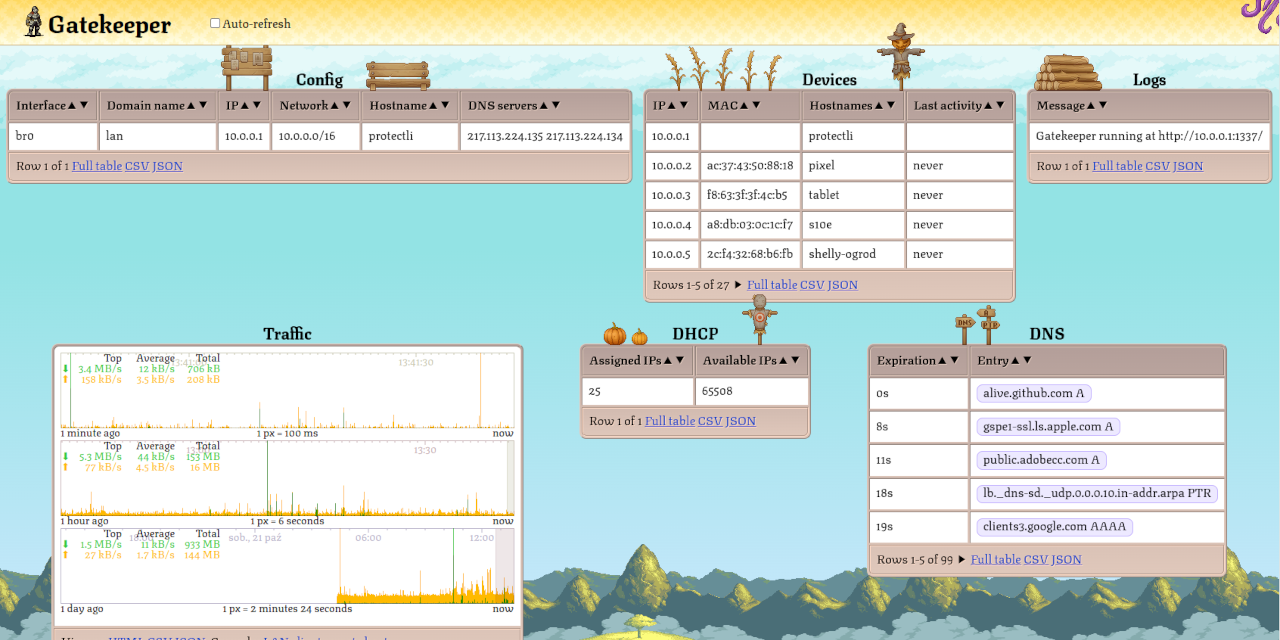Hi all home network administrators :) Haven’t posted anything here since June, when I told you about Gatekeeper 1.1.0. Back then it was a pretty bare-bones (and maybe slightly buggy) DNS + DHCP server with a web UI with a list of LAN clients. Back at 1.1.0 Gatekeeper didn’t even configure your LAN interface or set up NAT rules. It used to be something like dnsmasq - but with a web UI.
I’ve been improving it for the past couple of months - simplified it a lot, fixed bugs, optimized internals, improved the looks & added a bunch of quality-of-life features. Now it’s a program that turns any linux machine into a home internet gateway. It’s closer to OpenWRT in single executable file.
One big thing that happend was that I’ve attempted to replace the ubiquitous nft-based NAT (where the kernel processes the packets according to a rule-based script) with nfqueue (where the kernel sends the packet to userspace so that it can be altered arbitrarily). I’ve expected this to be buggy & slow. Well, it was hell to implement but it turns out that it’s not slow at all. On the debug build my router can push 60GiB+ / second over TCP (over virtualized ethernet of course). And I’m not even using any io_uring magic yet. Quite honestly I don’t even know how to explain it since it’s slightly above the peak DDR4 transfer rate (I’m running dual channel DDR4-3200). Maybe the pages are not flushed to RAM & are only exchanged through CPU caches? Anyway I’m pretty excited because userspace access to all traffic opens a lot of new possibilities…
The first thing is NAT. By default Linux only supports symmetric NAT, which is pretty secure but is also fairly hard for the peer-to-peer protocols to pierce. There are some patches that make Linux full-cone but they’re not, and are not expected to become a part of the mainline kernel (at least according to OpenWRT forums). Now, since we have access to every packet we can take care of this ourselves. We can create a couple hash tables to track connections, alter the source & destination IP, recomputing the checksums if necessary. Suddenly we can have full-cone NAT, on any linux machine, without patching the kernel! At runtime it’s not as configurable as netfilter + conntrack but it’s a whole lot simpler - since now we can use a general purpose programming language rather than netfilter rules.
Another cool feature that we can now have are truly realtime traffic graphs. Summary of each packet traversing the network boundary is immediately streamed to the connected web UIs over WebSocket. This is way faster than the alternatives based on reading some /proc/ or /sys/ files every couple of seconds. Gatekeeper also aggregates the traffic from the last 24 hours between each pair of hosts into a histogram with 100ms resolution and allow clients to view it, scroll through it, compute stats, download as JSON or CSV. You can retroactively check which device talked with what IP, at what time with unprecedented resolution.
My next step is going to be capturing the traffic that goes through into a 5MB circular buffer (separate buffer for each LAN client) & downloading it as Wireshark-compatible pcap files. Computationally it’s almost free. IoT devices usually don’t transmit a lot of data. 5MB may actually cover months of traffic for the simpler ones. If any device is did anything weird, it will finally be possible to investigate it - even after it already happened.
Long-term Gatekeeper could do even more. For example offer assistance in setting up TLS MITM, perform some online grouping / analysis on the live traffic.
I still have some ground work to do - like automatically setting up Wireless LAN, bridgidng multiple interfaces into a single one and I think there may be a bug that causes crashes when checking GitHub for updates. But I wanted to share it sooner rather than later. I hope that despite its imperfections some of you will find it useful!
(I’ve had some issues with cross-instance posting. This is attempt #6)



This sounds interesting, does implementing this, as a noob, make sense?
I understand that your goal is to learn something new.
In my opinion ambitious, goal-oriented projects may either backfire or turn you into a legend. There will be many issues along the way and while they are all ultimately solvable, the difficulty may kill your motivation. Alternatively, if you manage to power through, then after some period of learning (potentially years) and keeping the fixation on specific problem you might emerge as a domain expert. Either way it’s a risky bet.
If I might leave some advice for newcomers it would be to learn how to perform some simple tasks & focus on creating projects that you’re confident can be built from things you already know. Over time you’ll increase the repertoire of tasks that you can perform, and therefore be able to build increasingly advanced projects.